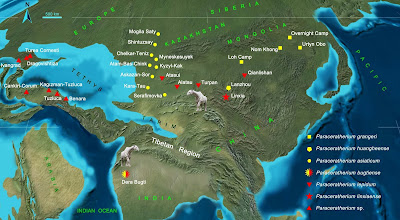Abstract
As one of the largest land mammals, the origin and evolution of the giant rhino Paraceratherium bugtiense in Pakistan have been unclear. We report a new species Paraceratherium linxiaense sp. nov. from northwestern China with an age of 26.5 Ma. Morphology and phylogeny reveal that P. linxiaense is the highly derived species of the genus Paraceratherium, and its clade with P. lepidum has a tight relationship to P. bugtiense. Based on the paleogeographical literature, P. bugtiense represents a range expansion of Paraceratherium from Central Asia via the Tibetan region. By the late Oligocene, P. lepidum and P. linxiaense were found in the north side of the Tibetan Plateau. The Tibetan region likely hosted some areas with low elevation, possibly under 2000 m during Oligocene, and the lineage of giant rhinos could have dispersed freely along the eastern coast of the Tethys Ocean and perhaps through some lowlands of this region.
Systematic paleontology
Perissodactyla Owen, 1848
Paraceratheriidae Osborn, 1923
Paraceratherium Forster-Cooper, 1911
Paraceratherium linxiaense sp. nov.
Diagnosis: Paraceratherium linxiaense possesses features that characterize the genus, such as a giant body size, long premaxillae with anterior ends extending downward, separated parietal crests, high condyle compared to the height of nuchal surface, lower inferior border of the posttympanic process than the condyle, roughly horizontal anterior part of symphysis, and downward turning cone-shaped I1. It is more derived than other species within this genus in having a larger body size, deeper nasal notch above M2, much higher occipital part and posterior end of zygomatic arch, and smaller upper incisor I1. The lower margin of the horizontal mandibular ramus is concave under the diastema, and small i1 extends anteriorly and horizontally. The dental formula is 1.0.3.3/1.0.3.3. P2 is semimolarized, while P3 and P4 are submolarized. The metaconule connects with the ectoloph and the anterior point of the hypocone in moderate wear; the antecrochet is moderate; the lingual border of the protocone is rounded on molars; and the ecto-posterior corner of the protolophid is angular on p3 and p4. The atlas has an expanded transverse foramen and a dumb-bell shaped vertebral fossa.
Age: IVPP locality LX1808 is faunally and paleomagnetically dated to the middle of chron C8r with an estimated age of 26.5 million years ago (Ma) in the late Oligocene (Fig. 5).
 |
| Type locality of Paraceratherium linxiaense sp. nov. Map showing the giant rhino fossil locality of the Linxia Basin in Wangjiachuan Village, Dongxiang County, Gansu Province, China. |
Tao Deng, Xiaokang Lu, Shiqi Wang, Lawrence J. Flynn, Danhui Sun, Wen He and Shanqin Chen. 2021. An Oligocene Giant Rhino provides insights into Paraceratherium Evolution. Communications Biology. 4: 639. DOI: 10.1038/s42003-021-02170-6








